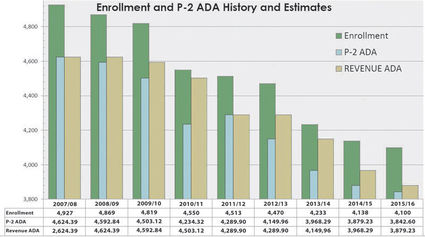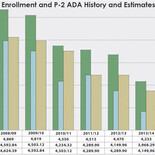Shedding Light On Local Issues
Common Core pumps up school budget revisions
The 2013-2014 second interim budget for the Tehachapi Unified School District, which updates the revenues and expenses for review by the Kern County Superintendent of Schools, includes additional funding for Secondary programs and Special Education mental health services.
Total revenues are projected to increase from $33,332,813 in the first interim budget report to $33,432,401.

The number of students in the Tehachapi Unified School District fell by almost 700 students in the seven years from 2007 to 2014. Predictions show an anticipated drop of more in the next two years, for a total loss of 827 students and the accompanying average daily attendance (ADA) revenue. Enrollment is the number of students present on census day at the beginning of the year. P-2 ADA is the average number of students at school, each day, from the first day of school through April 15. Revenue ADA is revenue funded on prior year or current year P-2 ADA. (Chart courtesy TUSD. See http://teh.k12.ca.us).
Reporting to the district trustees at the board meeting at the district board room on March 11, Nick Heinlein, chief administrator, business services, said that the Common Core grant plan the board approved in November of 2013 adds $614,000 in expenses. The district has actively been preparing elementary teachers for a transition from the existing California State Standards to the Common Core State Standards for writing (with increased emphasis on informational/explanatory writing).
"The only real change," Heinlein said, "is that instead of spending Common Core funding next year, we are spending it this year."
Heinlein said the district's student enrollment numbers, which show a steady seven-year decline with more loss projected over the next two years, "are lower than we like them to be." (See chart in bottom photo).
Seventy-seven point nine percent of the district's funding is dependent on the governor's new Local Control Funding Formula (LCFF), which requires enhanced funding for low income, English learners and foster youth.
"The governor is proposing the greatest increase in per-student average funding since 2000-01," Heinlein reported. "Only 14 months ago we were facing deep cuts if Proposition 30 didn't pass."
Missing in the 2014 state budget, Heinlein said, is money for unfunded CalSTRS pensions, special education shortfalls and early childhood education.













